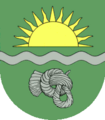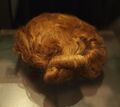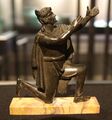Social:Suebian knot
The Suebian knot (German: Suebenknoten) is a historical male hairstyle ascribed to the tribe of the Germanic Suebi. The knot is attested by Tacitus in his 1st century AD work Germania, found on art by and depictions of the Germanic peoples, and worn by bog bodies.
Germania
According to Germania by Tacitus, the Suebian warriors combed their hair back or sideways and tied it into a knot, allegedly with the purpose of appearing taller and more awe-inspiring on the battlefield. Tacitus also reports that the fashion had spread to neighboring Germanic tribes among the younger warriors, while among the Suebians, the knot was sported even by old men as a status symbol, which "distinguishes the freeman from the slave", with the most artful knots worn by the most wealthy nobles.[1]
Archaeological record
Suebian knots were found to be worn by a number of bog bodies:
- Osterby Man,[2] 70–220 AD of Osterby near Rendsburg-Eckernförde, Schleswig-Holstein, Germany
- Dätgen Man,[3] 135–385 AD, and Dätgen, near Rendsburg-Eckernförde, Schleswig-Holstein, Germany
In 2000 at the Baltic Sea coast at Czarnowko near Lębork, Poland, a bronze kettle was found depicting males wearing the Suebian knot hairstyle.[4]
Depictions
Historical depictions are found on the Trajan column, the cauldron of Musov, the Tropaeum Traiani relief, and a bronze sculpture of a kneeling German in the Bibliothèque nationale de France.
Method
The hair is divided at the back in two uniform strands, slicked and laid in opposite directions around the head. On one side of the head, usually in the temporal region, the two strands are individually tightened in the same direction. The two strands are then twisted, whereby the rotation of the two individual strands loosens somewhat. A loop is formed from the resulting braid and the excess braid end is put in a loop through the loop. By natural untwisting the resulting knot tightens and stops without further aids. [5][6]
The Osterby Man had an incipient vertex balding and very long and thin hair. Experimental archaeological wearing tests with this hairstyle showed that the node just as well holds only at very long and thin hair, as in the bog body. [7] A certain amount of hair grease improves also the durability of the hairstyle. Strong and full hair is attributed to the decline in abundance of this hairstyle.
Gallery
Hair of bog body Dätgen Man (Germany)
See also
- Khokhol
- Sikha
- List of bog bodies
References
- ↑ "Germania". www.ourcivilisation.com. http://www.ourcivilisation.com/smartboard/shop/tacitusc/germany/chap1.htm. Retrieved 2013-12-19.
- ↑ Deem, James M (2003). Bodies from the Bog. Houghton Mifflin Harcourt. https://books.google.com/books?id=DppwAMTs5skC&pg=PT9&lpg=PT9&dq=osterby+head#PPT9,M1.
- ↑ Datgen Man . Mummytombs.com. Retrieved on 30 May 2012.
- ↑ M. Macynska, D. Rudnicka, Abstract: A grave with Roman imports from Czarnówko, Lębork district, Pomerania, Poland "Archived copy". Archived from the original on 2007-08-07. https://web.archive.org/web/20070807203411/http://www.dainst.org/medien/de/Germania_82-2.pdf. Retrieved 2007-10-15.
- ↑ http://www.osterby.de/osterby/Haartracht_Pelzschulterkragen/aussehen_moorleiche.htm
- ↑ Schlabow: Haartracht und Pelzschulterkragen der Moorleiche von Osterby.
- ↑ Haak: Einige Bemerkungen zum so genannten „Suebenknoten“. S. 179.
 |











